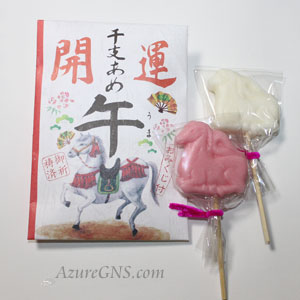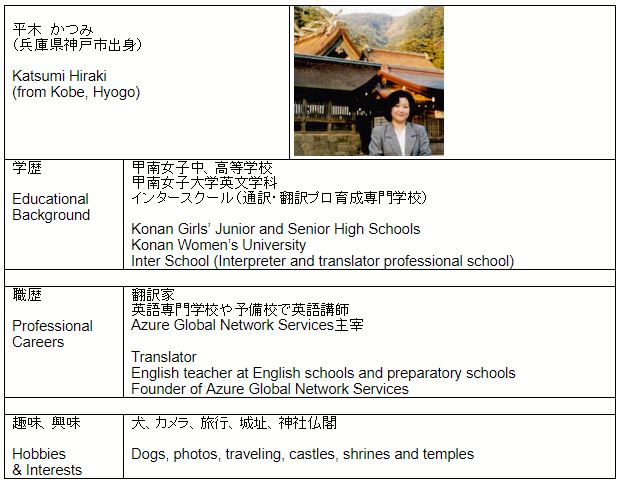十二支
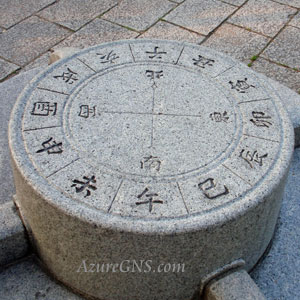
日本では60年を1周期とする、特有の年の数え方をしました。この概念は6世紀に中国から日本へ伝わりました。 60という数字は5組の要素と12の異なる動物の組み合わせからなります。 5組の要素は10個のサインが2つ1組になってできています。 これらの10個のサインは甲(こう)、乙(おつ)、丙(へい)、丁(てい)、戊(ぼ)、己(き)、庚(こう)、辛(しん)、壬(じん)、癸(き)です。 12の動物は子(鼠)、丑(牛)、寅(虎)、卯(兎)、辰(竜)、巳(蛇)、午(馬)、未(羊)、申(猿)、酉(鳥)、戌(犬)、亥(猪)です。 60の時間の分割は羅針盤の方位や、時刻、日付、月を表すのにも使われましたが、今日は年を示す場合や占いの際に方位を表す場合のみ使われます。
Each year in Japan was once considered to be a unique segment inside a 60-year cycle. This concept was introduced to Japan from China in the sixth century. The number 60 comes from the product of 5 pairs of elements and 12 different animals. The 5 pairs of elements are the combination of 2 signs out of the 10 following signs. These 10 signs are Ko, Otsu, Hei, Tei, Bo, Ki, Ko, Shin, Jin, Ki. The twelve animals are Ne (Rat), Ushi (Ox), Tora (Tiger), U (Rabbit), Tatsu (Dragon), Mi (Snake), Uma (Horse), Hitsuji (Sheep), Saru (Monkey), Tori (Chicken), Inu (Dog), and I (Wild Boar). The 60 divisions of time were also used to divide the compass for directions, and to indicate the time of day, days, and months, but nowadays they are only used to indicate years and fortune telling directions.
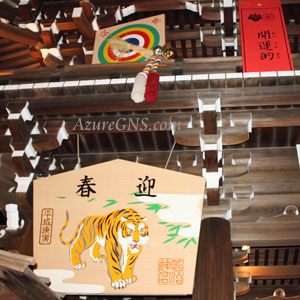
これらの12の動物の組み合わせは十二支、または干支と呼ばれ、その周期は12年ごとに繰り返され、順番が変わることはありません。その年と同じ動物の年に生まれた人々を年男(男性)、年女(女性)と呼びます。 生まれ年によって相手の年齢が推察できます。 人々が最も十二支を話題にする時は新年を迎える時です。 多くの人は年賀状にその年の動物の絵を使ったり、新年を迎える際にその年の動物の人形や絵を家に飾ります。 いたるところでその年の干支をさまざまな形で目にします。
The combination of these twelve animals are called Junishi, or Eto (the twelve signs of the oriental zodiac) whose cycle repeats every twelve years and does not change sequence. We can guess a person’s age through his or her animal. People born in a year of the animal that is being observed are called Toshi-otoko (for men) and Toshi-onna (for women). People talk about Junishi most when a new year comes. Pictures of the animal of the year are often used for their New Year cards, and dolls or pictures decorate houses on New Year’s Day. Various representations of the animal of the year are seen in many places.
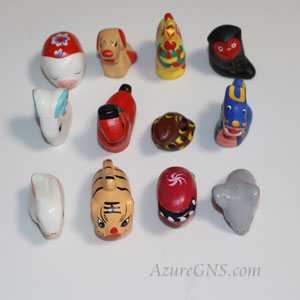
中国発祥の十二支がシルクロードを通って、アジア諸国、ロシア、ブルガリア、アラブ諸国にまでに伝わりましたが、動物の組み合わせは国によって少し異なります。日本以外の国では十二支の最後は猪ではなく豚です。 ベトナムでは牛が水牛、羊が山羊、兎が猫になっています。 タイ、チベット、ベラルーシュは兎の代わりに猫になっています。 インドでは酉は鶏ではなく、ガルダと呼ばれるヒンズー教と仏教の神話に登場する金色の神鳥です。 カザフスタンやモンゴルでは虎が豹に変わる場合があります。
Through the Silk Road, the concept of Junishi was introduced to many countries such as Asian countries, Russia, Bulgaria and Arab states, but some of them assign different animals. All the countries except Japan place the Pig at the end of the Junishi instead of the Wild Boar. In Vietnam, the Water Buffalo replaces the Cow, the Goat replaces the Sheep, and the Cat replaces the Rabbit. In Thailand, Tibet and Belarus, the Cat replaces the Rabbit. In India, the Chicken is substituted by the Garuda, a sacred golden bird in both Hindu and Buddhist mythology. In Kazakhstan and Mongolia, the Tiger is sometimes changed into the Leopard.
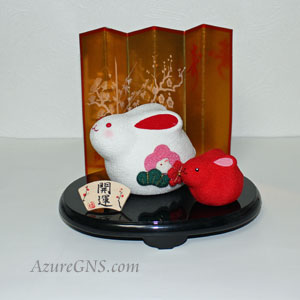
60年周期を達成する、つまり60歳の時に還暦と呼ばれる長寿のお祝いをします。 60年周期の後、再び始まるという発想から、赤ちゃんが着るような赤いちゃんちゃんこと帽子を贈る伝統があります。 しかし、近年では寿命も伸び、60歳で年寄りとは言えなくなってきました。 それ故に、年寄り扱いを敬遠して、還暦のお祝いはあまりしなくなっています。
After a person has gone through the entire 60-year cycle, at the age of 60, he or she has a celebration of longevity called Kanreki. Because of the idea of making a fresh start after a 60-year cycle, a red vest and a red hat similar to what a baby wears are traditionally given to the person celebrating his or her 60th birthday. However, as the life expectancy has recently become longer, 60-year old people are no longer considered to be elderly. Therefore, people dislike treating 60-year old people as elderly, and 60-year old people dislike being treated as elderly, so the celebration of Kanreki has been passing gradually.
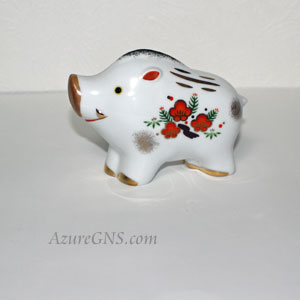
人々は自分の生まれた年の動物の性格に似ると言われています。 私は猪年で性格も体形も似ていると家族に言われます。 確かに私は行動力があり、頑固で、ダイエットの必要もあります。 私の守護神である猪の肉は決して口にしません。
It is said that people share character traits with the animal of the year they were born. I was born in the year of the Wild Boar, so my family told me that both of my character and figure are similar to the Wild Boar. Indeed, I am an active and obstinate person and need to lose weight. I never eat the meat of the Wild Boar, my guardian animal.
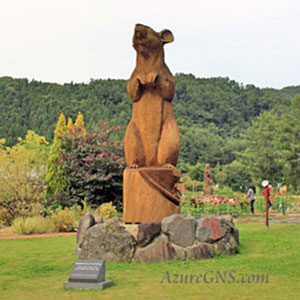
<子 Ne, Rat>
◆【長所】 愛想が良く、気配りができ、清潔です。
【Good Point】 The Rat is an amiable, considerate, and clean person.
◆【短所】 欲深い面もあり、色事で失敗することもあります。
【Bad Point】 The Rat can be greedy and sometimes tends to fail in its life because of love affairs.
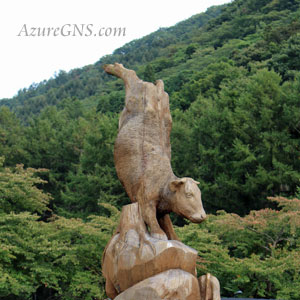
<丑 Ushi, Ox>
◆【長所】 真面目で、忍耐強く、働き者です。
【Good Point】 The Ox is earnest, patient, and a hard worker.
◆【短所】 時々強情になり、口下手な人もいます。
【Bad Point】 The Ox is sometimes stubborn, and can be a poor talker.
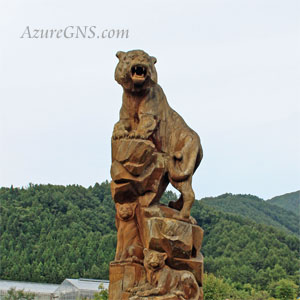
<寅 Tora, Tiger>
◆【長所】 大胆で思慮深く、慈悲の心があります。
【Good Point】 The Tiger is courageous, thoughtful, and charitable.
◆【短所】 ときおり自信過剰で、我儘なところが少しあります。
【Bad Point】 The Tiger is occasionally overconfident and can be a little selfish.
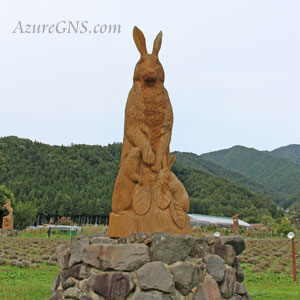
<卯 U, Rabbit>
◆【長所】 情にもろく、愛嬌があり、才覚があります。
【Good Point】 The Rabbit has a tender heart, and is charming and witty.
◆【短所】 時に根気が無くなることもあり、男女間のトラブルがあるかもしれません。
【Bad Point】 The Rabbit is sometimes thought of as impatient and may have some trouble with its love life.
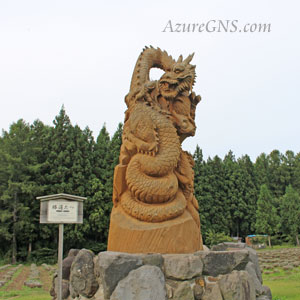
<辰 Tatsu, Dragon>
◆【長所】 自尊心が強く、機敏で、一途です。
【Good Point】 The Dragon is proud, quick, and sincere.
◆【短所】 愛想があまり良くなく、短気な人もいます。
【Bad Point】 The Dragon is sometimes said to be unsociable, and can be short-tempered.
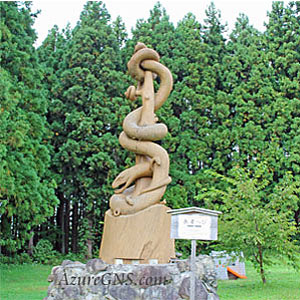
<巳 Mi, Snake>
◆【長所】 思慮分別があり、冷静沈着で、金運があります。
【Good Point】 The Snake is deliberate, cool-headed, and has luck with money.
◆【短所】 やや猜疑心が強く、嫉妬深い面があります。
【Bad Point】 The Snake can tend to be a little suspicious and jealous.
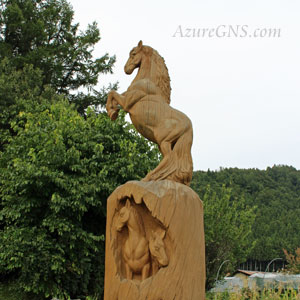
<午 Uma, Horse>
◆【長所】 陽気で、人気者、そして面倒見が良い人です。
【Good Point】 The Horse is a merry, popular, and obliging person.
◆【短所】 軽率な面が時にあり、やや短絡的かもしれません。
【Bad Point】 The Horse is sometimes considered thoughtless, and may be a little simple.
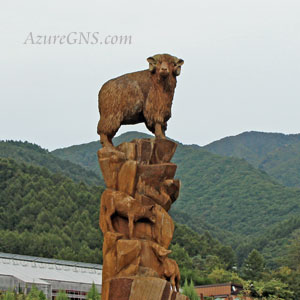
<未 Hitsuji, Sheep>
◆【長所】 温和で親切、慈悲心に富んだ人です。
【Good Point】 The Sheep is gentle, kind and merciful.
◆【短所】 少し臆病で、マイナス思考になる傾向にあります。
【Bad Point】 The Sheep can be a little timid and tends to be negative.
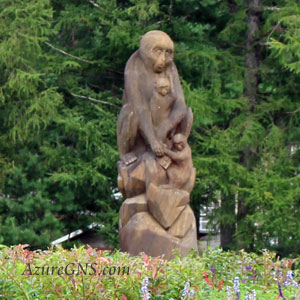
<申 Saru, Monkey>
◆【長所】 器用で利口、そして財運があります。
【Good Point】 The Monkey is dexterous, clever, and fortunate with money.
◆【短所】 時々飽きっぽく、時に意地悪なところがあるでしょう。
【Bad Point】 The Monkey sometimes loses interest in things and is a little mean at times.
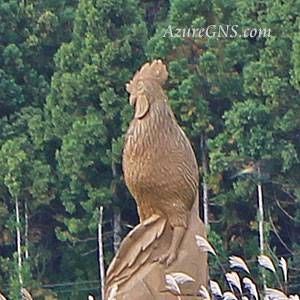
<酉 Tori, Chicken>
◆【長所】 賢明で世渡り上手、弁舌が立ちます。
【Good Point】 The Chicken is sensible, worldly-wise, and has the gift of the gab.
◆【短所】 移り気なところがあり、多忙なわりに結実しないこともあります。
【Bad Point】 The Chicken can be changeable, and on occasions has difficulty bearing the fruits of its labor though it is very busy.
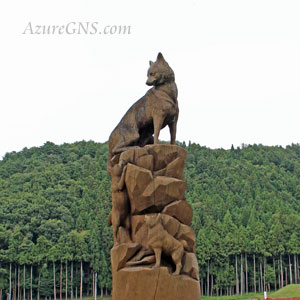
<戌 Inu, Dog>
◆【長所】 義理堅く、正直で、勤勉です。
【Good Point】 The Dog has a strong sense of duty, is honest and industrious.
◆【短所】 偏屈なところもあり、時々くよくよします。
【Bad Point】 The Dog can be eccentric and sometimes worries too much.
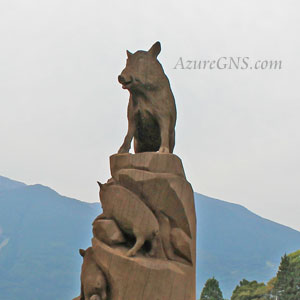
<亥 Inoshishi, Wild Boar>
◆【長所】 潔白で、決断力があり、侠気があります。
【Good Point】 The Wild Boar is an innocent, decisive, and chivalrous person.
◆【短所】 短気で、頑固者が多いとされています。
【Bad Point】 The Wild Boar is thought of as being irritable and obstinate.
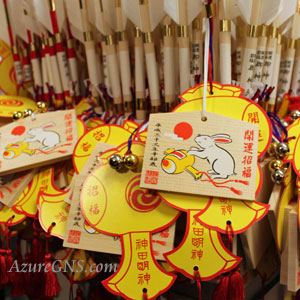
干支早見表
The Chart of the Twelve Animal Signs
| 1920 | 大正 7年 |
申 | Saru | さる | Monkey |
| 1921 | 大正 8年 |
酉 | Tori | とり | Chicken |
| 1922 | 大正 9年 |
戌 | Inu | いぬ | Dog |
| 1923 | 大正 10年 |
亥 | Inoshishi | いのしし | Wild Boar |
| 1924 | 大正 11年 |
子 | Ne (Nezumi) |
ねずみ | Rat |
| 1925 | 大正 12年 |
丑 | Ushi | うし | Ox |
| 1926 | 昭和 元年 |
寅 | Tora | とら | Tiger |
| 1927 | 昭和 2年 |
卯 | U (Usagi) |
うさぎ | Rabbit |
| 1928 | 昭和 3年 |
辰 | Tatsu | たつ | Dragon |
| 1929 | 昭和 4年 |
巳 | Mi (Hebi) |
へび | Snake |
| 1930 | 昭和 5年 |
午 | Uma | うま | Horse |
| 1931 | 昭和 6年 |
未 | Hitsuji | ひつじ | Sheep |
| 1932 | 昭和 7年 |
申 | Saru | さる | Monkey |
| 1933 | 昭和 8年 |
酉 | Tori | とり | Chicken |
| 1934 | 昭和 9年 |
戌 | Inu | いぬ | Dog |
| 1935 | 昭和 10年 |
亥 | Inoshishi | いのしし | Wild Boar |
| 1936 | 昭和 11年 |
子 | Ne (Nezumi) |
ねずみ | Rat |
| 1937 | 昭和 12年 |
丑 | Ushi | うし | Ox |
| 1938 | 昭和 13年 |
寅 | Tora | とら | Tiger |
| 1939 | 昭和 14年 |
卯 | U (Usagi) |
うさぎ | Rabbit |
| 1940 | 昭和 15年 |
辰 | Tatsu | たつ | Dragon |
| 1941 | 昭和 16年 |
巳 | Mi (Hebi) |
へび | Snake |
| 1942 | 昭和 17年 |
午 | Uma | うま | Horse |
| 1943 | 昭和 18年 |
未 | Hitsuji | ひつじ | Sheep |
| 1944 | 昭和 19年 |
申 | Saru | さる | Monkey |
| 1945 | 昭和 20年 |
酉 | Tori | とり | Chicken |
| 1946 | 昭和 21年 |
戌 | Inu | いぬ | Dog |
| 1947 | 昭和 22年 |
亥 | Inoshishi | いのしし | Wild Boar |
| 1948 | 昭和 23年 |
子 | Ne (Nezumi) |
ねずみ | Rat |
| 1949 | 昭和 24年 |
丑 | Ushi | うし | Ox |
| 1950 | 昭和 25年 |
寅 | Tora | とら | Tiger |
| 1951 | 昭和 26年 |
卯 | U (Usagi) |
うさぎ | Rabbit |
| 1952 | 昭和 27年 |
辰 | Tatsu | たつ | Dragon |
| 1953 | 昭和 28年 |
巳 | Mi (Hebi) |
へび | Snake |
| 1954 | 昭和 29年 |
午 | Uma | うま | Horse |
| 1955 | 昭和 30年 |
未 | Hitsuji | ひつじ | Sheep |
| 1956 | 昭和 31年 |
申 | Saru | さる | Monkey |
| 1957 | 昭和 32年 |
酉 | Tori | とり | Chicken |
| 1958 | 昭和 33年 |
戌 | Inu | いぬ | Dog |
| 1959 | 昭和 34年 |
亥 | Inoshishi | いのしし | Wild Boar |
| 1960 | 昭和 35年 |
子 | Ne (Nezumi) |
ねずみ | Rat |
| 1961 | 昭和 36年 |
丑 | Ushi | うし | Ox |
| 1962 | 昭和 37年 |
寅 | Tora | とら | Tiger |
| 1963 | 昭和 38年 |
卯 | U (Usagi) |
うさぎ | Rabbit |
| 1964 | 昭和 39年 |
辰 | Tatsu | たつ | Dragon |
| 1965 | 昭和 40年 |
巳 | Mi (Hebi) |
へび | Snake |
| 1966 | 昭和 41年 |
午 | Uma | うま | Horse |
| 1967 | 昭和 42年 |
未 | Hitsuji | ひつじ | Sheep |
| 1968 | 昭和 43年 |
申 | Saru | さる | Monkey |
| 1969 | 昭和 44年 |
酉 | Tori | とり | Chicken |
| 1970 | 昭和 45年 |
戌 | Inu | いぬ | Dog |
| 1971 | 昭和 46年 |
亥 | Inoshishi | いのしし | Wild Boar |
| 1972 | 昭和 47年 |
子 | Ne (Nezumi) |
ねずみ | Rat |
| 1973 | 昭和 48年 |
丑 | Ushi | うし | Ox |
| 1974 | 昭和 49年 |
寅 | Tora | とら | Tiger |
| 1975 | 昭和 50年 |
卯 | U (Usagi) |
うさぎ | Rabbit |
| 1976 | 昭和 51年 |
辰 | Tatsu | たつ | Dragon |
| 1977 | 昭和 52年 |
巳 | Mi (Hebi) |
へび | Snake |
| 1978 | 昭和 53年 |
午 | Uma | うま | Horse |
| 1979 | 昭和 54年 |
未 | Hitsuji | ひつじ | Sheep |
| 1980 | 昭和 55年 |
申 | Saru | さる | Monkey |
| 1981 | 昭和 56年 |
酉 | Tori | とり | Chicken |
| 1982 | 昭和 57年 |
戌 | Inu | いぬ | Dog |
| 1983 | 昭和 58年 |
亥 | Inoshishi | いのしし | Wild Boar |
| 1984 | 昭和 59年 |
子 | Ne (Nezumi) |
ねずみ | Rat |
| 1985 | 昭和 60年 |
丑 | Ushi | うし | Ox |
| 1986 | 昭和 61年 |
寅 | Tora | とら | Tiger |
| 1987 | 昭和 62年 |
卯 | U (Usagi) |
うさぎ | Rabbit |
| 1988 | 昭和 63年 |
辰 | Tatsu | たつ | Dragon |
| 1989 | 平成 元年 |
巳 | Mi (Hebi) |
へび | Snake |
| 1990 | 平成 2年 |
午 | Uma | うま | Horse |
| 1991 | 平成 3年 |
未 | Hitsuji | ひつじ | Sheep |
| 1992 | 平成 4年 |
申 | Saru | さる | Monkey |
| 1993 | 平成 5年 |
酉 | Tori | とり | Chicken |
| 1994 | 平成 6年 |
戌 | Inu | いぬ | Dog |
| 1995 | 平成 7年 |
亥 | Inoshishi | いのしし | Wild Boar |
| 1996 | 平成 8年 |
子 | Ne (Nezumi) |
ねずみ | Rat |
| 1997 | 平成 9年 |
丑 | Ushi | うし | Ox |
| 1998 | 平成 10年 |
寅 | Tora | とら | Tiger |
| 1999 | 平成 11年 |
卯 | U (Usagi) |
うさぎ | Rabbit |
| 2000 | 平成 12年 |
辰 | Tatsu | たつ | Dragon |
| 2001 | 平成 13年 |
巳 | Mi (Hebi) |
へび | Snake |
| 2002 | 平成 14年 |
午 | Uma | うま | Horse |
| 2003 | 平成 15年 |
未 | Hitsuji | ひつじ | Sheep |
| 2004 | 平成 16年 |
申 | Saru | さる | Monkey |
| 2005 | 平成 17年 |
酉 | Tori | とり | Chicken |
| 2006 | 平成 18年 |
戌 | Inu | いぬ | Dog |
| 2007 | 平成 19年 |
亥 | Inoshishi | いのしし | Wild Boar |
| 2008 | 平成 20年 |
子 | Ne (Nezumi) |
ねずみ | Rat |
| 2009 | 平成 21年 |
丑 | Ushi | うし | Ox |
| 2010 | 平成 22年 |
寅 | Tora | とら | Tiger |
| 2011 | 平成 23年 |
卯 | U (Usagi) |
うさぎ | Rabbit |
| 2012 | 平成 24年 |
辰 | Tatsu | たつ | Dragon |
| 2013 | 平成 25年 |
巳 | Mi (Hebi) |
へび | Snake |
| 2014 | 平成 26年 |
午 | Uma | うま | Horse |
| 2015 | 平成 27年 |
未 | Hitsuji | ひつじ | Sheep |
| 2016 | 平成 28年 |
申 | Saru | さる | Monkey |
| 2017 | 平成 29年 |
酉 | Tori | とり | Chicken |
| 2018 | 平成 30年 |
戌 | Inu | いぬ | Dog |
| 2019 | 亥 | Inoshishi | いのしし | Wild Boar | |
| 2020 | 子 | Ne (Nezumi) |
ねずみ | Rat | |
| 2021 | 丑 | Ushi | うし | Ox | |
| 2022 | 寅 | Tora | とら | Tiger | |
| 2023 | 卯 | U (Usagi) |
うさぎ | Rabbit | |
| 2024 | 辰 | Tatsu | たつ | Dragon | |
| 2025 | 巳 | Mi (Hebi) |
へび | Snake | |
| 2026 | 午 | Uma | うま | Horse | |
| 2027 | 未 | Hitsuji | ひつじ | Sheep | |
| 2028 | 申 | Saru | さる | Monkey | |
| 2029 | 酉 | Tori | とり | Chicken | |
| 2030 | 戌 | Inu | いぬ | Dog | |
| 2031 | 亥 | Inoshishi | いのしし | Wild Boar |
